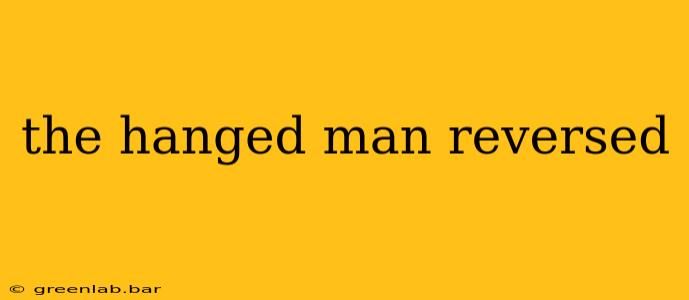The Hanged Man in the Tarot is a card of surrender, sacrifice, and perspective shifts. But when reversed, its meaning takes on a fascinating, and sometimes frustrating, twist. This isn't simply about a lack of surrender; it suggests a resistance to necessary pauses, a clinging to the status quo, or an inability to see the bigger picture. Understanding the nuances of the reversed Hanged Man requires delving into its potential interpretations.
Understanding the Upright Hanged Man
Before exploring the reversed meaning, let's briefly revisit the upright Hanged Man. This card encourages introspection, a willingness to see things from a different angle, and the acceptance of temporary setbacks as opportunities for growth. It often signifies:
- Surrender: Letting go of control and trusting the process.
- Sacrifice: Making difficult choices for the greater good.
- New Perspectives: Gaining a broader understanding of a situation.
- Suspension: A temporary pause before moving forward.
- Spiritual Growth: Deepening one's connection to intuition and higher self.
The Hanged Man Reversed: Key Interpretations
The reversed Hanged Man indicates a resistance to the lessons presented by the upright card. It speaks to a refusal to surrender, a clinging to outdated perspectives, and a stubborn avoidance of necessary changes. Key interpretations include:
1. Stubborn Resistance to Change:
This is perhaps the most common interpretation. The reversed Hanged Man suggests a refusal to see the bigger picture or adapt to changing circumstances. There might be a stubborn clinging to old habits, beliefs, or relationships, even when they are no longer serving you. This resistance can lead to stagnation and missed opportunities.
2. Procrastination and Inaction:
Delay and inaction are strong themes here. Instead of embracing the necessary pause suggested by the upright card, the reversed Hanged Man indicates a paralyzing fear of taking action or making decisions. This can stem from fear of failure, indecisiveness, or a lack of clarity.
3. Missed Opportunities:
By clinging to outdated perspectives and avoiding necessary changes, the reversed Hanged Man can signify missed opportunities for growth and advancement. The individual may be so focused on their current viewpoint that they fail to recognize the potential benefits of a different approach.
4. Lack of Perspective:
While the upright Hanged Man encourages a shift in perspective, the reversed card highlights a lack of it. The individual may be too close to the situation to see it objectively, resulting in poor decisions and missed opportunities for resolution.
5. Self-Sabotage:
In some readings, the reversed Hanged Man can represent self-sabotage. The individual might unconsciously create obstacles or delay progress, stemming from deep-seated fears or insecurities.
How to Navigate the Reversed Hanged Man
The reversed Hanged Man is not inherently negative; it's a call to action. It urges you to:
- Examine your resistance: Identify the underlying reasons for your reluctance to change or surrender.
- Seek a new perspective: Try to see the situation from a different angle. Seek advice from trusted friends or mentors.
- Embrace necessary delays: Sometimes, a pause is essential for clarity and progress. Don't rush into decisions.
- Break free from old patterns: Identify harmful habits or beliefs holding you back and actively work to change them.
- Trust your intuition: Listen to your inner voice and allow it to guide your decisions.
The reversed Hanged Man is a powerful reminder that growth often requires stepping outside of our comfort zones. By understanding its message and actively working to address the challenges it presents, you can transform potential stagnation into meaningful progress. The key is to recognize the resistance and consciously choose a different path.

